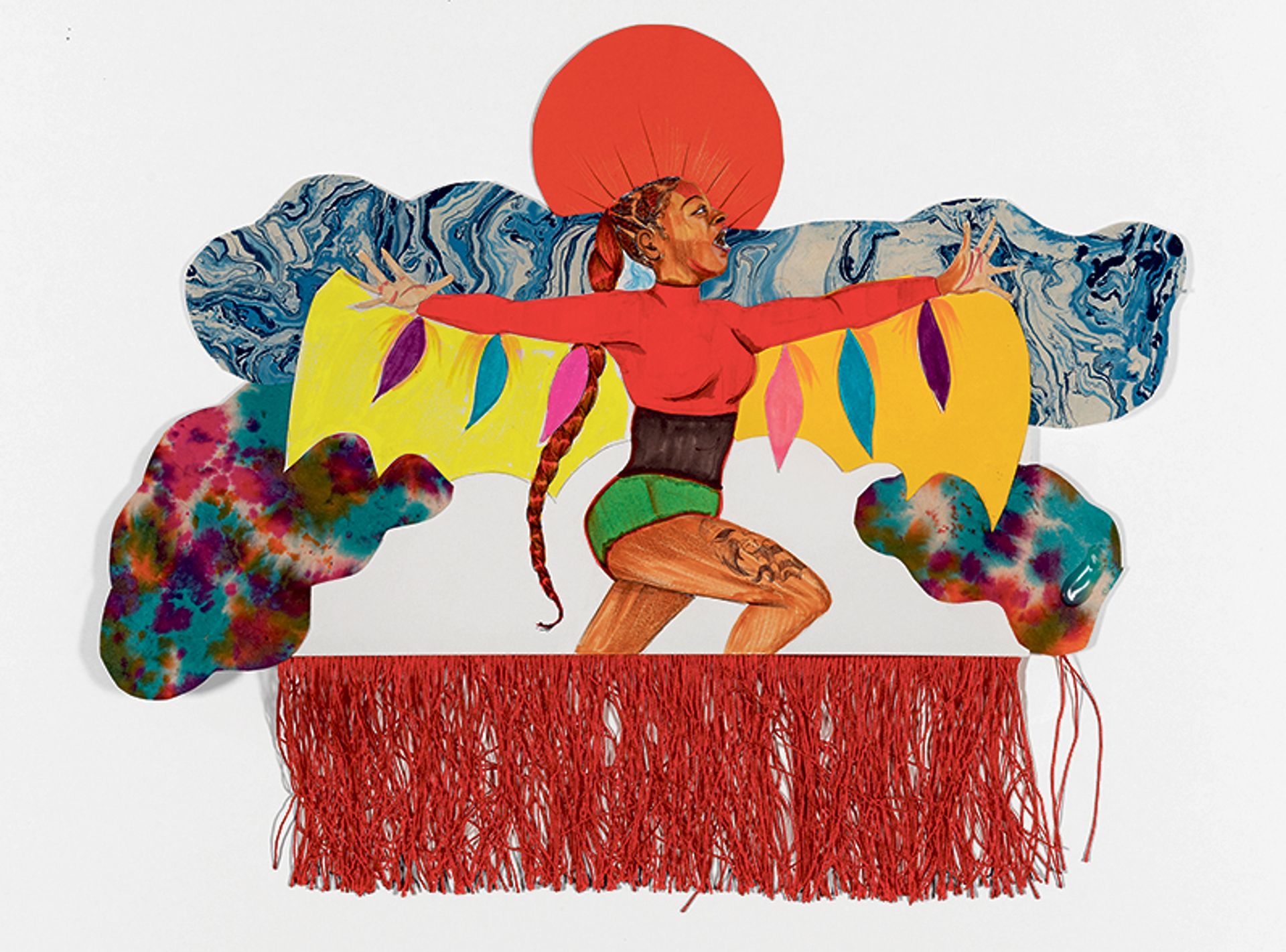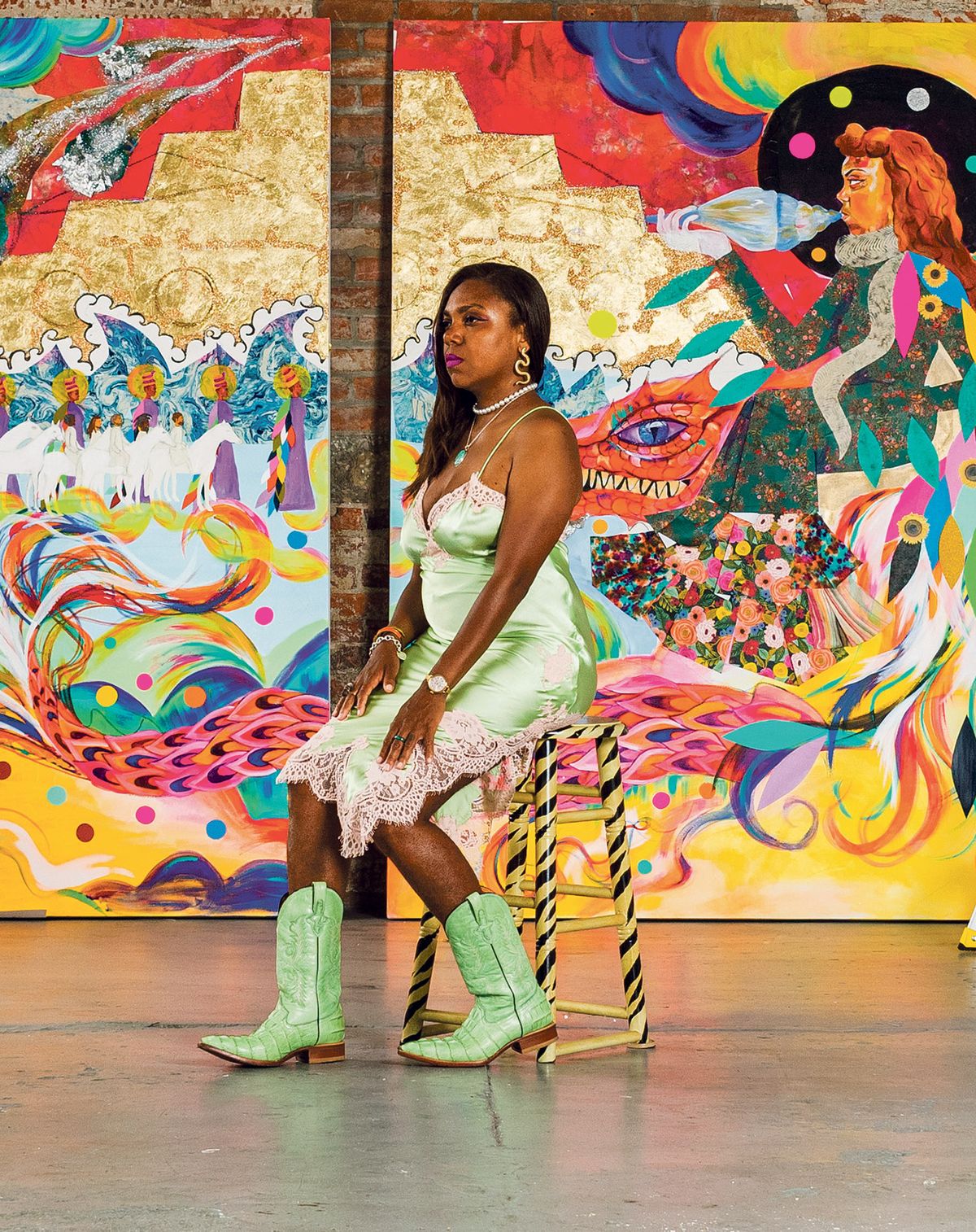In 1974 Sun Ra, the Afrofuturist pioneer and avant-garde jazz musician, debuted his science-fiction film, Space Is the Place, an experimental “blaxploitation” romp depicting his visit to Oakland, California, after settling on a new planet with his crew, the Arkestra. As the movie begins and the spaceship first blooms into view amid a sea of stars, a disembodied voice chants, “It’s after the end of the world; don’t you know that yet?”, then is drowned out by anarchic peals of trumpeting. This expansive relationship to linear time appears throughout the practice of the painter Jamea Richmond-Edwards, so it is no wonder that she cites Sun Ra as one of the primary artistic inspirations for Ancient Future, her exhibition at the Museum of Contemporary Art North Miami.

In Dark Night of the Soul (2023), Richmond-Edwards draws on influences ranging from Egyptology and cosmology to natural disasters and Black musicians Photo: Zachary Balber; courtesy the artist and Kravets Wehby Gallery
Richmond-Edwards’s paintings, collages and videos transport viewers to a galaxy far, far away from the confines of white supremacy. Her universe grounds Black mythologies and hopeful, alternative environments in self-portraiture and figural composition, reaching across media to form a bridge between past and present. The show includes a new two-channel video work that braids her experiences with marching band and majorette culture at historically Black colleges and universities (HBCUs) with a musical score by her 19-year-old son, an emerging jazz musician in their home state of Maryland. The Art Newspaper caught up with the artist to discuss the space-time continuum and the liberatory modality of imagination.
The Art Newspaper: Ancient Future seems to represent a creative breakthrough for you. What are some of the shifts you’ve experienced in the process of mounting the show?
Jamea Richmond-Edwards: The show is a launching pad. I am interested in really creating an immersive experience. In terms of what my aspirations are as an artist, I’m thinking about the pyramids of Giza, I’m thinking about temples. For me, the temple is a representation or allegory of the human body. With ancient or older architecture—Byzantine, Baroque, Art Deco—you’re immersed in this world. When people walk into my exhibition, how do I fully immerse them?
This notion of outer space can also manifest as inner space: what environments, what landscapes can you imagine yourself in?
Part of this exhibition is me looking beyond this construct of humanity. I’ve been increasingly growing interested in Sun Ra. He has this famous film called Space Is the Place. I’m starting to understand that this notion of outer space can also manifest as inner space: what environments, what landscapes can you imagine yourself in? So, when I’m thinking about other galaxies, I’m really talking about the inner spaces of my mind.
Since your work is rooted in this Afrofuturist logic, could you talk about how you are conceiving of time?
It’s really about dispelling time. Time is a construct, and that’s one thing that I’m very cognisant of. We’re simultaneously living in the past, present and future right now. Watches and clocks exist, but time doesn’t. What does exist is this very cyclical nature of what we would call time. If you study it long enough, you will begin to see patterns. I use that understanding of history—or my perception of history and time—to imagine this idea of the future, which is me actively writing my story in terms of how I want it to play out. What I realised as I’ve been talking about my work is that it’s a form of escapism. This is a 2023 conversation, but this is also a very ancient conversation; our ancestors had very different relationships to themselves and the cosmos. That, for me, is what this exhibition is about.

A drawing from The Unraveling (2023), a series of 12 works Photo: Zachary Balber; courtesy the artist and Kravets Wehby Gallery
Speaking of escapism, what is the role of fantasy in your work, and how does that impact your choices in medium or genre?
I view my studio not just as a place to make work, but as a sanctuary. I’m an alchemist. As I begin examining history and looking at it, particularly looking at Indigenous cosmology, there’s a lot of fantasy and mythos involved. As I’m navigating through this existence, this reality, I’m rocking with the mythos. I am the author of these paintings and also the author of my reality. I look at this way of storytelling as a way to use naturalism, including mythos, to capture the textures of the juiciest story. How can I make one scene or one channel for the viewer to be invited into my world? I’ve given myself permission to say, “Fuck it, y’all gotta come into my world.” And this has been an exercise of agency and freedom.
That for me really kicked off three years ago in the pandemic, when I realised during that time of isolation and being away from friends and family how stifled I had been creatively. I discovered that there were certain parameters on my imagination. I thought it to be very revolutionary work to paint myself as the heroine. It was very uncomfortable, using myself, at first. So yes, these are paintings, but this is art therapy at the same time. I was at a very low place, so over these past two years working towards this exhibition, I promised myself to trust my mind and my spirit.
In terms of where these ideas go, I’m open to different media. That’s really countering my Western education, which tends to be very linear—like, “You’re a painter, you should have one style,” etcetera. I’m breaking these rules, a lot of which I probably placed on myself. Those niches and all those constructs are just little boxes; they can become a prison.
• Jamea Richmond-Edwards: Ancient Future, until 17 March 2024, Museum of Contemporary Art, North Miami


